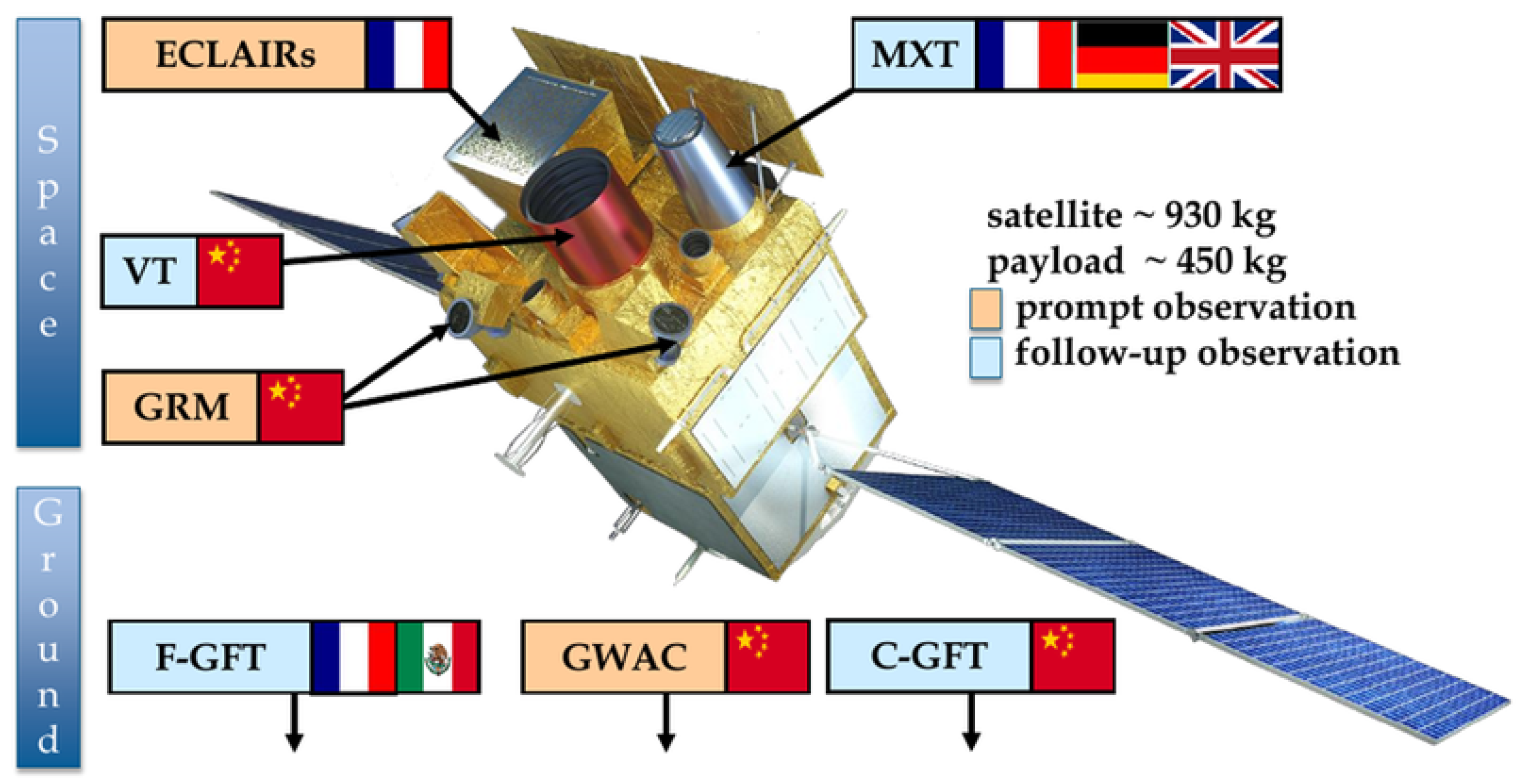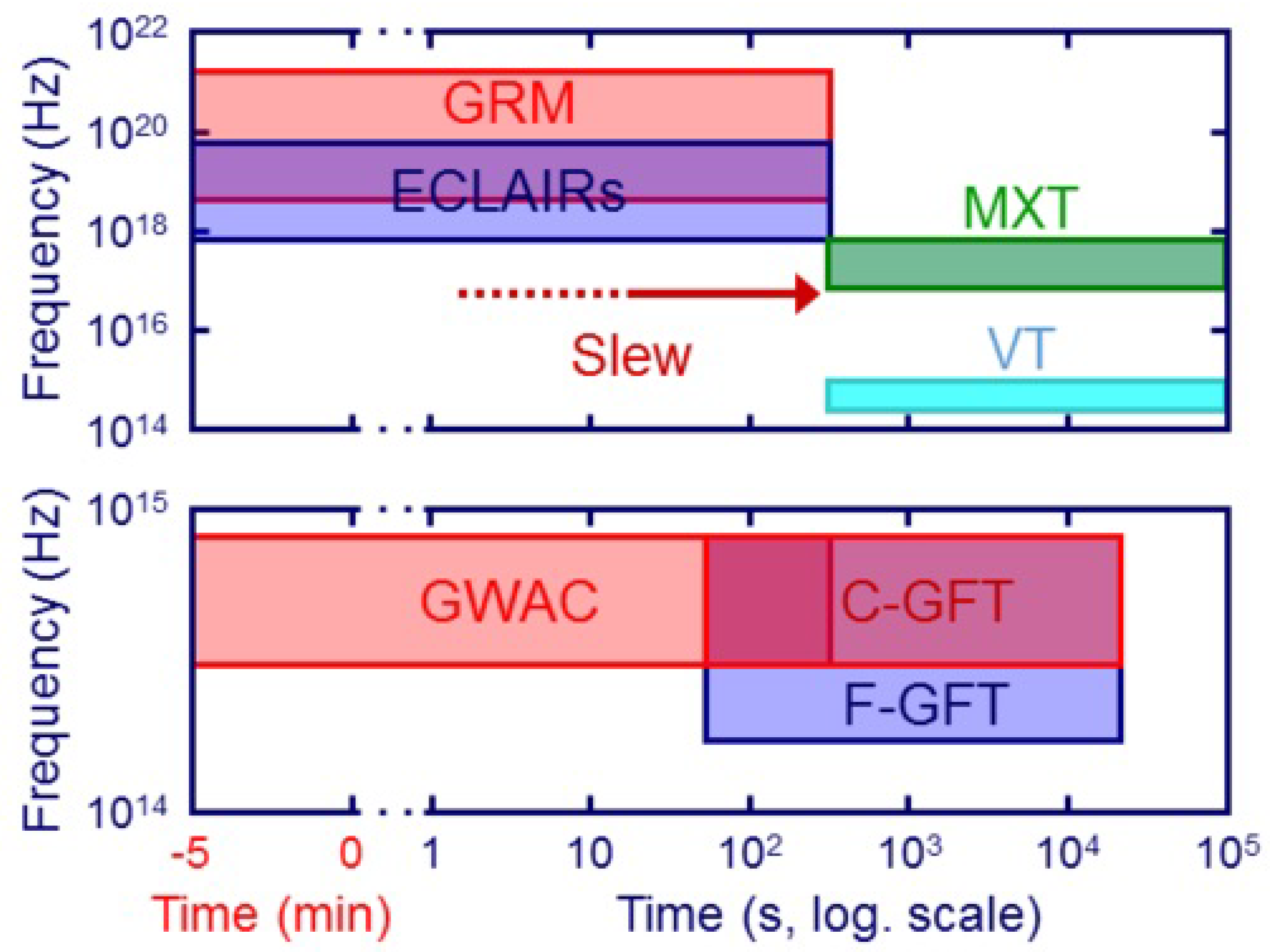1. Overview of the Mission
SVOM (Space-based multiband astronomical Variable Objects Monitor) is a sino-french mission that is dedicated to Gamma-Ray Burst (GRB) science and, more generally, to the discovery and multi-wavelength follow-up of transient sources. It is expected to be launched in mid 2023 for a nominal duration of three years, plus an extended duration of two additional years. The mission includes four space-based and three ground-based instruments (
Figure 1) that, working together, will provide multi-wavelength follow-up of the targets in order to obtain a complete coverage of the GRB emission over seven decades in energy, from the trigger up to the very late phases of the afterglow (see
Figure 2). In particular, SVOM will be able to trigger and locate GRBs, and distribute alerts and accurate localization in real time. In addition to that, SVOM will adopt an optimal pointing strategy for ground-based follow-up, fostering synergies with other space and ground-based facilities and allowing for a large fraction of GRBs detected and observed with redshift measurements.
SVOM is the result of a collaboration between the Chinese and French national space agencies, CNSA (China National Space Administration) and CNES (Centre national d’études spatiales), with the main contributions from the Institute of Research into the Fundamental Laws of the Universe (Irfu) and the Research Institute of Astrophysics and Planetology (IRAP) for France and the National Astronomical Observatory (NAOC) and the Beijing High Energy Institute (IHEP) for China.
In the following, we describe the instruments and the observational strategy (
Section 2) and give an overview of the main science cases that can be addressed with SVOM (
Section 3). Finally, we outline the crucial role that SVOM will play thanks to its characteristics and its synergies with the large ground-based facilities that will be operational in the next decade (
Section 4).
2. Instruments and Observational Strategy
The SVOM satellite will be launched by the Chinese Long March 2C rocket from the Xichang launch base, and will be put into an orbit with a 30-degree inclination, an altitude of 625 km and an orbital period of 96 min. It will be equipped with four instruments, two French and two Chinese:
The telecope ECLAIRs (France), a coded-mask instrument with a field of view of 2 sr, capable of triggering and locating GRBs with a precision of less than 12’ in the 4–120 keV energy band;
The Gamma-Ray burst Monitor (GRM; China), composed by three units that together cover a larger field of view than ECLAIRs (∼ 5.6 sr) and extend its energy band up to 5 MeV;
The Microchannel X-ray Telescope (MXT; France, with Germany and UK participation), that detects GRBs in the 0.2–10. keV energy band and is capable of locating them with a precision < 13″;
The Visible Telescope (VT; China), that observes GRBs in the visible band (400–1000 nm) and can localize them with a precision ∼ 1″.
These instruments will be supported by three ground-based facilities:
The Ground–based Wide Angle Camera instrument (GWAC; China) consists of two sets of 16 wide-field cameras. Each set covers a field of view of 2500 deg2, which is about 30% of the field of view of ECLAIRs. The first set is already operational and installed in the eastern part of China (Xinglong). The second set will be installed in the western part of China (Muztagh);
Two 1-m class robotic GFTs (Ground Follow-up Telescopes; one French with Mexican contribution, one Chinese), that operate in the visible and Near Infrared (NIR) bands (400–1700 nm and 400–900 nm, respectively).
When a GRB is triggered within the field of view of ECLAIRs, the satellite automatically slews within a few minutes to repoint the two narrow-field instruments on board, MXT and VT, to provide fast detection and accurate localization of the possible X-ray and optical counterparts. The alert messages and the preliminary information collected are transmitted to the ground in about 10 s at Very High Frequency (VHF) in a frequency band between 137 and 138 MHz by an on-board antenna. The messages are then downlinked through a network of radio stations that, to ensure permanent contact with the satellite, will consist of ∼45 VHF antennae homogeneously deployed in the inter-tropical zone around the Earth, between latitudes −30° and +30°. They will relay every alert message from the satellite to the French Science Center (FSC) located at Saclay in France. After a first analysis at the FSC, the messages will be distributed to the whole scientific community through the GCN alert network or other networks available, in particular to the GFTs robotic telescopes that will refine the GRB position and give an initial indication of distance.
The rapid follow-up of SVOM-detected GRBs with ground-based optical telescopes in order to have a redshift measurement for a large fraction of them (∼2/3) is one of the scientific objectives of the mission. In order to avoid targets that are too close to the Sun and are thus not accessible by ground telescopes during their nighttime, an optimal pointing strategy will be adopted such that the optical axis of the instruments on board the satellite point in the direction opposite to the Sun. This choice implies that the Earth will hide the field of view of the instruments once per orbit, up to 50% of the period of revolution.
3. Science Cases
In the following, we give a description of the SVOM main observing programs, the GRB “core” program, the general program, and the Target of Opportunities (ToOs) program. For a complete discussion of all the science cases related to these programs, we refer to Wei, Cordier et al. (2016) [
1].
The core program: Thanks to the unique properties of the mission outlined in
Section 2, SVOM will provide a unique sample of ∼30–40 GRBs/yr with: (i) Complete coverage of the prompt emission over three decades in energy, thanks to the synergy between ECLAIRs and GRM (see e.g.,
Figure 3 and [
2]), and possibly the detection of the prompt optical counterpart with the GWAC (16% of cases); (ii) the X-ray counterpart observed from a few minutes after the trigger up to a few days in X-rays, optical, and NIR; and (iii) a redshift measurement for ∼2/3 of them, allowing for a complete study of their physical properties in the rest frame. The low-energy threshold of ECLAIRs and the extension to the NIR of the GFTs will allow SVOM to tackle many open issues in GRBs science, as high-redshift GRBs (z > 5) that allows to probe the primordial universe, or soft GRBs (X-ray rich and X-ray flashes) and ultra-long GRBs ([
3,
4], see also
Figure 3) that will shed light to the nature of the progenitors in the local universe and the physics of explosion. The joint observations of ECLAIRs and GRM will increase the efficiency in detecting short GRBs that, besides their interest per se, are one of the possible counterparts of Gravitational Wave (GW) emitters. Finally, the possible detection (or limits from the non-detection) of the optical counterpart of the GRB prompt emission will open a new window for unexpected discoveries.
The general program: Although SVOM is a mission specifically designed for GRB science, its characteristics will find many applications in the study of many extra-galactic sources as Active Galactic Nucleai (AGN), Ultra-Luminous X-ray sources (ULX), and Tidal Disruption Events (TDE), and galactic sources as accreting systems, pulsars, magnetars, and flaring stars.
Rapid follow-up observations: Thanks to its flexibility, SVOM will be a powerful tool for the multi-wavelength follow-up of transients discovered by external facilities and not triggered by SVOM. This will be possible thanks to a Target of Opportunities (ToOs) program. SVOM will take advantage from wide-field instruments such as ECLAIRs, GRM, and GWAC to search for the counterparts at different wavelengths of events discovered by external facilities, and also of an X-ray telescope (MXT) with a field of view of 1 deg
2 that will allow SVOM to cover larger regions than Swift/XRT. This will be particularly important to identify the Electromagnetic (EM) counterparts of GW or neutrino emitters. Indeed, SVOM will have a specific ToO program dedicated to EM counterpart search in response to a multi-messenger alert. Concerning GW alerts, SVOM already joined the first three observing runs of the Advanced LIGO and Virgo interferometers with part of the ground segment (see e.g., [
5]), and will be ready to join the first part of O4 (starting in late 2022) with its ground-based instruments before the launch of the spacecraft.
4. Conclusions
Time-domain, multi-messenger astronomy is a recognized priority in the next decade (see e.g., Pathways to Discovery in Astronomy and Astrophysics for the 2020s the National Academies of Science, Engineering and Medicine’s latest decadal survey
1), and the role of small-size space missions is considered to be crucial to both discover new transients and fully characterize them throughout the EM spectrum. SVOM will play a major role in this context. Thanks to its flexibility, the characteristics of the instruments and the observation strategies, it will: (i) Provide a unique sample of GRBs monitored over seven decades in energy and with redshift measurement, that can be used for population studies; (ii) open new discovery windows for GRB science (soft GRBs in the local universe, optical prompt emission, and high-redshift GRBs); (iii) complement current missions that are aging, as Fermi and Swift; and (iv) be a powerful tool to search for and characterize EM counterparts of external triggers. Concerning this last point, SVOM is specifically designed to foster synergies with the large ground-based facilities, and this aspect will be even more vital when the Cherenkov Telescope Array (CTA), the Vera Rubin Observatory (LSST), or the Square Kilometre Array (SKA) will be operational. Missions like SVOM are also necessary to fully exploit the scientific potential of transient astrophysical phenomena discovered via GWs and neutrinos, since these events also require EM observations across the spectrum for identification and further study.








